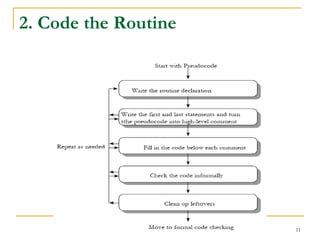The pseudocode
- 1. The Pseudo code Programming Process Code Complete Author : Steven C. McConnell. Prof. Asha N 1
- 2. Summary of Steps in Building Classes and Routines Creating a general design for the class is an iterative process class creation can be a messy process for all the reasons that design is a messy process Prof. Asha N 2
- 3. Steps in Creating a Class Create a general design for the class Construct each routine within the class Review and test the class as a whole Prof. Asha N 3
- 4. Steps in Building a Routine creating a routine— designing the routine, checking the design, coding the routine, and checking the code Prof. Asha N 4
- 5. Pseudo code for Pros “pseudocode” – English-like notation for describing how an algorithm, a routine, a class, or a program will work Pseudocode Programming Process (PPP) defines a specific approach to use pseudocode to streamline the creation of code within routines. Prof. Asha N 5
- 6. Contd… guidelines for using pseudocode Use English-like statements that precisely describe specific operations. Avoid syntactic elements from the target programming language. Write pseudocode at the level of intent. Write pseudocode at a low enough level that generating code from it will be nearly automatic. Prof. Asha N 6
- 7. Contd… Example of Bad Pseudocode increment resource number by 1 allocate a dlg struct using malloc if malloc() returns NULL then return 1 invoke OSrsrc_init to initialize a resource for the operating system *hRsrcPtr = resource number return 0 Prof. Asha N 7
- 8. Contd… Example of Good Pseudocode Keep track of current number of resources in use If another resource is available Allocate a dialog box structure If a dialog box structure could be allocated Note that one more resource is in use Initialize the resource Store the resource number at the location provided by the caller Endif Endif Return TRUE if a new resource was created; else return FALSE Prof. Asha N 8
- 9. Constructing Routines Using the PPP the activities involved in constructing a routine 1. 2. 3. 4. 5. Design the routine Code the routine Check the code Clean up leftovers Repeat as needed Prof. Asha N 9
- 10. 1. Design the Routine Check the prerequisites Define the problem the routine will solve Name the routine Decide how to test the routine Think about error handling Think about efficiency Research functionality available in the standard libraries Research the algorithms and data types Write the pseudocode Think about the data Check the pseudocode Try a few ideas in pseudocode, and keep the best (iterate) Prof. Asha N 10
- 11. 2. Code the Routine Prof. Asha N 11
- 12. 3. Check the Code Mentally check the routine for errors Compile the routine Step through the code in the debugger Test the code Remove errors from the routine Prof. Asha N 12
- 13. 4. Clean Up Leftovers take several cleanup steps to make sure that the routine’s quality is up to your standards Check the routine’s interface Check for general design quality Check the routine’s data Check the routine’s statements and logic Check the routine’s layout Check the routine’s documentation. Remove redundant comments Prof. Asha N 13
- 14. 5. Repeat Steps as Needed If the quality of the routine is poor, back up to the pseudocode. High-quality programming is an iterative process, so don’t hesitate to loop through the construction activities again. Prof. Asha N 14














